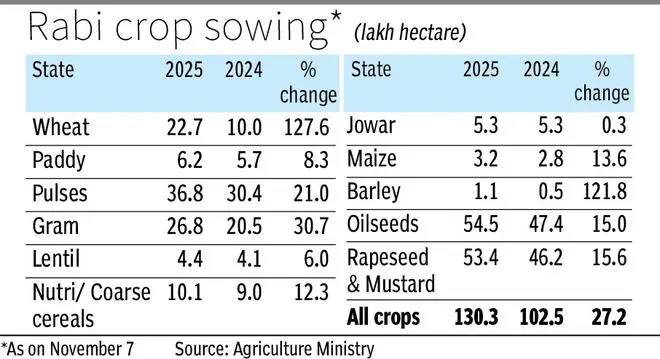Wheat acreage more than doubles on early harvest of Kharif crops


According to the latest data compiled by the agriculture ministry, the sown area under wheat as of November 7 was 22.72 lakh hectares compared with 9.98 lakh hectares a year ago.
| Photo Credit:
–
Sowing areas under all Rabi season crops have gained an early lead due to the normal harvesting of Kharif crops, which cleared fields promptly for planting the winter crops
The total area under all crops has risen 27 per cent to over 130 lakh hectares (lh) from 102 lh year-ago, with wheat acreage more than doubling. The majority of the paddy crop has been harvested in Punjab (93 per cent) and Haryana (78 per cent). In Uttar Pradesh, 52 per cent of the paddy area has been cleared for wheat sowing as of November 9.

Early Gains
As the government has fixed a target of 171.14 million tonnes (mt) of foodgrains — including 119 mt of wheat, 15.86 mt of rice, 16.57 mt of pulses, 3.17 mt of nutri cereals, 14.5 mt of maize and 2.05 mt of barley — as well as 15.07 mt of oilseeds (including 13.9 mt of mustard), the early progress in sowing may help farmers achieve normal or higher yields, if weather remain conducive.
According to the latest data compiled by the agriculture ministry, the sown area under wheat as of November 7 was 22.72 lh compared with 9.98 lh year-ago.
The Karnal-based Indian Institute of Wheat and Barley Research (IIWBR) had advised farmers to select varieties carefully, based on sowing time and the conditions to get higher yields. “Seed should be purchased from a trusted source,” it said in its advisory for the first fortnight of November. Highlighting that the current temperature is suitable for timely sowing of wheat, it said that machine sowing is preferred by farmers this season to save time, labour and seed.
“In a combine-harvested paddy field, direct wheat seeding can be done using Happy Seeder or Smart Seeder in the presence of loose crop residue. Follow timely planting and avoid delays in sowing of wheat to avoid yield losses due to (potential) adverse effects of heat around maturity,” it said.
The wheat research institute of ICAR has also said that farmers should avoid growing varieties recommended for other zones to avoid risk of disease susceptibility and that seeds should be treated with Carboxin 75 WP @ 2.5 g/kg, Carbendazim 50 WP @ 2.5 g/kg, or Tebuconazole 2DS @ 1.25 g/kg before sowing.
Broader gains
Among other crops, the sowing area under the Rabi paddy was 8.3 per cent higher at 6.18 lh, compared with 5.71 lh last year and maize was 13.6 per cent higher at 3.21 lh from 2.83 lh. Barley acreage more than doubled to 1.12 lh from 0.51 lh and jowar stood at 5.28 lh against 5.26 lh. Total acreage under nutri/coarse cereals was 10.13 lh, up 12.3 per cent from 9.02 lh.
In pulses, the sown area rose to 36.83 lh from 30.43 lh a year ago. The area under chana (gram) was 26.81 lh, compared with 20.51 lh, an increase of 30.7 per cent. However, masur (lentil) acreage saw a modest 6 per cent rise to 4.38 lh from 4.13 lh.
The oilseeds acreage stood at 54.46 lh as of November 7, up 15 per cent from 47.35 lh and this included 53.35 lh under mustard, which was 15.6 per cent higher than 46.15 lh year-ago, the data show.
Last year, the total area under all Rabi crops for the full season was 663.04 lh, with foodgrains production at 167.22 mt and oilseeds at 13.57 mt.
Published on November 11, 2025




